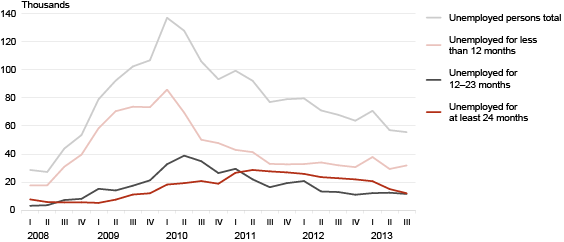In the 3rd quarter unemployment stabilised
According to the data of the Labour Force Survey, the unemployment rate changed marginally in the 3rd quarter compared to the previous quarter (it was 8.1% in the 2nd quarter). Compared to the same quarter of the previous year (9.7%) the unemployment rate declined significantly. The estimated number of unemployed persons was 56,000 in the 3rd quarter, which is 12,000 persons less compared to the same quarter of the previous year.
Compared to the same quarter of the previous year, there was a decrease primarily in the number of the long-term unemployed (i.e. people who had been looking for a job for one year or longer). They numbered 24,000 in the 3rd quarter of 2013, which is 12,000 less compared to the same quarter of the previous year. The long-term unemployment rate was 3.4% in the 3rd quarter and declined primarily due to the diminishing number of the very long-term unemployed (unemployed for two years or more). The number of the short-term unemployed (i.e. people who had been looking for a job for under a year) remained stable, totalling 32,000 in the 3rd quarter of this year as well as in the 3rd quarter of last year. There was no significant difference in unemployment among men and women.
By age group, unemployment decreased more among young and middle-aged persons. The unemployment rate of the elderly has declined at a slower pace and compared to the previous quarter even increased slightly (to 7.2%). The youth unemployment rate (i.e. the share of unemployed persons aged 15–24 among the labour force of the same age) was 14.5% in the 3rd quarter, which is notably smaller than in the previous quarter as well as in the same quarter of the previous year (when the youth unemployment rate was 16.1% and 19.5%, respectively). The young unemployed numbered 10,000 in total. As the unemployment rate is calculated as a share of those young people who are economically active, but most of this age group is still studying, the share of the unemployed among all young people aged 15–24 was 5.9%.
In the 3rd quarter, the employment rate of the population aged 15–74 was 62.6%. It increased compared the same quarter of the previous year (by 0.7 percentage points), but decreased slightly compared to the previous quarter (by 0.4 percentage points). The estimated number of employed persons was 641,000 in the 3rd quarter. The yearly growth in employment was most of all influenced by an increase in the number of persons employed in wholesale and retail trade, accommodation and food service, administrative and support service activities, and manufacturing.
The share of economically inactive persons (students, retired persons, homemakers, discouraged persons, etc.) in the population aged 15–74 increased a little and was 32% in the 3rd quarter. The estimated number of economically inactive persons was 328,000. The main reasons for inactivity are retirement, studies and health problems. Discouraged persons (i.e. persons who have stopped seeking a job) numbered about 6,000 in the 3rd quarter.
In the calculation of the estimates for 2012 and 2013, the estimated number of population published by Statistics Estonia as of 1 January 2012 has been used to ensure the comparability in time series; this population figure has not been adjusted with the data of the 2011 Population and Housing Census. The Labour Force Survey data for 2000–2013 will be adjusted after the revision of the population number during the years between the two censuses and will be published in the 1st quarter of 2014.
Unemployment rate is the share of the unemployed in the labour force (the sum of employed and unemployed persons). Long-term unemployment rate is the share of people who have been unemployed for a year or longer among the total labour force. Employment rate is the share of the employed in the working-age population (aged 15–74). The estimates are based on the data of the Labour Force Survey. Statistics Estonia has been conducting the Labour Force Survey since 1995 and every quarter 5,000 persons participate in the survey. The Labour Force Survey is carried out by statistical organisations in all the European Union Member States on the basis of a harmonised methodology.
Unemployed persons by duration of unemployment, 1st quarter 2008 – 3rd quarter 2013
